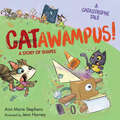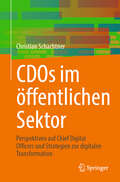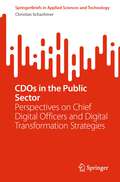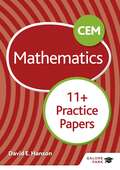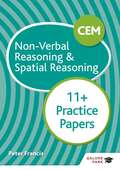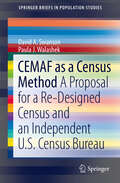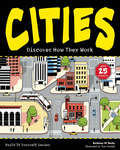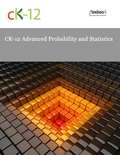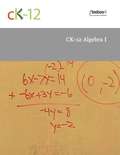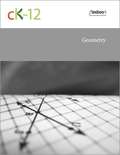- Table View
- List View
CATastrophe!: A Story of Patterns
by Ann Marie StephensNine kittens go on an exciting boating adventure that's a (funny) CATastrophe in this playful picture book that demonstrates the key math concept of patterns.A crew of hungry kittens and their captain head to the lake to catch some dinner, but the fish have surprises in store for them. Physics is at work too. What happens when confused kitties paddle every which way? Or when they all lean in the same direction? A pattern is needed to avoid a catastrophe! Patterns are the foundation on which math is built. Using strong rhythm, clever wordplay, and countable characters, CATastrophe! is a fun read-aloud that also shows what patterns can do. Helpful backmatter will deepen readers' understanding and challenge them to find more patterns in this book and in our world.
CATawampus!: A Story of Shapes (A Catastrophe Tale)
by Ann Marie StephensMath-loving kittens race to build the best robot as they compete in a STEM day at school in this playful picture book that demonstrates the key math concept of identifying shapes.It&’s a wonderful day—because it&’s STEM day! Kitties are challenged to build a robot and use the wind to make it move. With circles, squares, triangles, and rectangles, the kitties do their best to tape, glue, and paste—but oh no! The robot won&’t move. How might these disorderly cats make sense of all these shapes and build a successful robot? Author Ann Marie Stephens draws upon more than 30 years of teaching experience to ensure that readers absorb math while having fun in the adventure-filled CATastrophe Tale series. And Jenn Harney&’s hilarious and energetic illustrations capture the antics of these enthusiastic kittens.Each book in the CATastrophe Tale series includes helpful back matter, which shows readers that, just like the kittens, they use mathematical skills in their everyday lives. Additional titles in the series include CATastrophe!: A Story of Patterns and sCATtered!: A Story of Estimation.
CBAC Lefel 2 Mathamateg Ychwanegol(Welsh edition)
by Andrew GintyStretch and challenge students with this introduction to higher level mathematics.Including plenty of practice activities and worked examples, this book bridges the gap from GCSE to A-level, building students' reasoning and problem-solving skills in preparation for the next step.- Develop understanding of mathematics with discussion points, thought-provoking activities and rigorous exercise questions- Build confidence with notes on how prior knowledge can be applied to tackle new concepts- Develop problem-solving skills with step-by-step worked examples and practice questions- Be aware of potential misunderstandings with common pitfalls noted throughout the text- Check progress using a checklist of key points and learning outcomes at the end of each chapter- Help students to achieve their potential with two practice papers at the end of the bookAnswers to exercise questions are at the back of the book and online, alongside full worked solutions and mark schemes for the practice papersPlease note: this is a Welsh-language edition
CDOs im öffentlichen Sektor: Perspektiven auf Chief Digital Officers und Strategien zur digitalen Transformation
by Christian SchachtnerDieses Buch untersucht die Notwendigkeit innovativer Ansätze zur Administrationsdigitalisierung, indem Technologien wie KI, Blockchain und intelligente Prozesse genutzt werden, um den Erwartungen der Bürger gerecht zu werden. Besonderes Augenmerk liegt auf der Rolle der Chief Digital Officers (CDOs) bei der erfolgreichen digitalen Transformation innerhalb öffentlicher Institutionen. Die digitale Verwaltung erfordert frische Impulse, um mit den Fortschritten im Industriesektor Schritt zu halten, indem Technologien wie KI-gesteuerte Automatisierung, Blockchain-Transaktionen und Sicherheitswerkzeuge eingesetzt werden. Intelligente Prozesslösungen werden als transformativ angesehen, um die Service-Standards gemäß den Erwartungen der Bürger an den Staat aufrechtzuerhalten. Im Gegensatz zu kommerziellen Unternehmen bietet die Zusammenarbeit denjenigen, die die Digitalisierung im öffentlichen Sektor überwachen, erweiterte Skalierungsmöglichkeiten, indem sie auf Erfahrungen aus anderen Regionen und Metropolen zurückgreifen, die direkt anwendbar und wiederverwendbar sind. Im öffentlichen Bereich spiegeln digitale Strategien rechtliche und soziale Bedingungen wider, was Anpassungen und Anpassungsoptionen für Chief Digital Officers erforderlich macht, während sie die digitale Transformation leiten. Methodische Schwerpunkte in der Neugestaltung von Aufgabenstrukturen, Prozessoptimierung und der Motivation von Akteuren ergeben vielfältige Handlungsfelder für die neue Rolle des CDO in öffentlichen Institutionen. Dieses Buch untersucht die Instrumente, Strategien und Einstellungen, die notwendig sind, um transformative Initiativen in Organisationen erfolgreich umzusetzen, und betont bewährte Konzepte mit praktischer Anwendbarkeit, die es den Lesern ermöglichen, ihre eigenen Interaktionsmöglichkeiten als digitale Führungspersönlichkeiten abzuleiten. Das Buch ist eine prägnante Einführung in die spezifischen Anforderungen an visionäre Gestalter, die dynamische Veränderungen in nutzerzentrierten öffentlichen Dienstleistungen vorantreiben.
CDOs in the Public Sector: Perspectives on Chief Digital Officers and Digital Transformation Strategies (SpringerBriefs in Applied Sciences and Technology)
by Christian SchachtnerThis book explores the need for innovative approaches to administrative digitization, leveraging technologies such as AI, blockchain, and smart processes to meet citizens' expectations, with a particular focus on the role of Chief Digital Officers (CDOs) in driving successful digital transformations within public institutions. Administrative digitization requires fresh inputs to match the leaps seen in the industry sector, utilizing technologies like AI-driven automation, blockchain transactions, and security tools. Smart process solutions are seen as transformative in upholding service standards aligned with citizens' state expectations. Unlike commercial companies, collaboration offers those overseeing public sector digitization enhanced scaling opportunities by drawing from experiences in other regions and metropolises, directly applicable and reusable. In the public realm, digital strategies mirror legal and social conditions, necessitating adjustments and adaptation options for Chief Digital Officers as they lead digital transformation. Methodological focal points in task structure redesign, process optimization, and motivating actors yield diverse action areas for the CDO's new role in public institutions. This book explores the instruments, strategies, and attitudes necessary to successfully implement transformative initiatives in organizations, emphasizing proven concepts with practical applicability, enabling readers to derive their own interaction options as digital guidance leaders. The book is a concise introduction to the specific requirements for visionary designers driving dynamic changes in user-centric public services.
CEM 11+ Mathematics Practice Papers
by David E HansonExam Board: ISEBLevel: 11 PlusSubject: MathsFirst Teaching: September 2015First Exam: Autumn 2016Brand new for 2016, these practice exam papers prepare children for the most challenging pre-tests and 11 plus independent school examinations. Nine levelled exam papers with a total of 184 questions are designed to test pupil's ability across all mathematical topics:- there are four training tests, which include some simpler questions and slower timing designed to develop confidence- four tests in the style of pre-tests, ISEB and short-format CEM in terms of difficulty, speed and question variation- one test in the style of the longer format GL/bespoke tests in multiple choice question formatThe papers will develop and perfect exam technique, and will teach pupils to improve their response rates with timed papers. Pupils will ...- become familiar with the way long-format 11 plus tests are presented- build exam-room confidence by practising with a variety of exam paper styles- work with the most challenging question setThe brand new 11 plus and pre-test range has been constructed to help pupils follow a three step revision journey ..Step 1) 11 Plus Maths Revision GuideStep 2) Practice Papers11 Plus Maths Practice Papers 111 Plus Maths Practice Papers 2Step 3) Workbooks10-Minute Maths Tests Workbook Age 8-10 10-Minute Maths Tests Workbook Age 9-11 Mental Arithmetic Workbook Age 8-10 Mental Arithmetic Workbook Age 9-11
CEM 11+ Non-Verbal Reasoning & Spatial Reasoning Practice Papers: For 11+, Pre-test And Independent School Exams Including Cem, Gl And Iseb
by Peter FrancisThese three practice exam papers test pupils ahead of the CEM 11+ Non-Verbal Reasoning test, including those taking bespoke tests created by CEM for individual schools. Three levelled papers test pupils' skills in non-verbal and spatial reasoning.The papers are designed to:- Develop and perfect exam technique for all CEM 11+ Non-Verbal Reasoning tests- Teach pupils to improve their response rates with timed papers- Identify weaker areas and improve results by studying the answers, which contain references to Galore Park's revision materials for guidance and useful tips- The resource also contains links to downloadable answer sheets so that the tests can be re-sat.These practice papers are part of Galore Park's 11+ revision series, which provides a three-step learning journey that teaches children the skills needed to pass rigorous school entrance exams.
CEMAF as a Census Method: A Proposal for a Re-Designed Census and An Independent U.S. Census Bureau (SpringerBriefs in Population Studies)
by David A. Swanson Paula J. WalashekIn provocative terms that push the envelope of technical, administrative, and legal capabilities, Swanson and Walashek propose a re-vamped US census based neither on the current system, self-enumeration, nor its predecessor, door-to-door canvassing. Instead, they propose that it be built on a combination of four elements: (1) administrative records; (2) the continuously updated Master Address File; (3) survey data; and (4) modeling and imputation techniques. They use "Census-Enhanced Master Address File (CEMAF) as a descriptive term for their proposal, which is based on four principles and includes a proposal for an independent Census Bureau. They argue that evidence suggests that the methods used to conduct traditional census counts may be at the end of their useful working lives, as evidenced by increasing costs and declining response rates. Some of their ideas will seem farfetched. However, Swanson and Walashek believe this is the time to discuss radical proposals as governments re-examine the utility of traditional census counts and consider reductions, as is the case in Canada and England. This SpringerBriefs should be on the reading list of staff in statistical agencies grappling with rising costs and declining response rates, as well as census stakeholders concerned about costs, accuracy, and census utility.
CFD-Modellierung: Grundlagen und Anwendungen bei Strömungsprozessen
by Rüdiger SchwarzeIn diesem kompakten Lehrbuch legt der Autor die Methodik der numerischen Simulation von Strömungsprozessen dar. Nach einer konzisen Erläuterung der Grundlagen lernen Leser das Potenzial der Methodik anhand von Anwendungsbeispielen kennen. Demonstriert werden sowohl einfache wie komplexe Probleme. Während Leser die einfachen Problemstellungen mithilfe von Open-Source-Softwarepaketen selbst bearbeitet können, sind die komplexen Beispiele aus aktuellen grundlagenorientierten und aus anwendungsnahen Forschungsprojekten des Autors abgeleitet.
CITIES
by Kathleen M. Reilly Tom CasteelTo a child, a city is a chaotic, vibrant community whose workings can seem quite mysterious. How did people create subways? How does the water get to the very top of a skyscraper? Is there any organization to a bustling metropolis? Cities: Discover How They Work will give kids a view into the inner functioning of these urban areas. They'll learn about all the parts that come together to make cities work and how they've grown and changed since the very first riverside settlements.Fascinating sidebars, unique illustrations, Words to Know, and fun Did You Know facts combine with age-appropriate hands-on activities to make learning about complex urban environments fun and reinforce learning. Projects include creating subway cut-aways to understand how transportation systems work, building an aqueduct to learn how cities get water, and experimenting with skyscraper design and water filtration. This STEAM title, which integrates science, technology, engineering, art, and math includes a glossary, list of resources, and index. Cities meets common core state standards in language arts for reading informational text and literary nonfiction and is aligned with Next Generation Science Standards. Guided Reading Levels and Lexile measurements indicate grade level and text complexity.
CK-12 Advanced Probability and Statistics
by Ck-12 FoundationCK-12 Foundation's Advanced Probability and Statistics FlexBook covers the following chapters: An Introduction to Analyzing Statistical Data - Students learn definitions of statistical terminology, and review data, measures of center, and measures of spread. Visualizations of Data - histograms and frequency distributions, common graphs and data plots, and box-and-whisker plots. An Introduction to Probability - events, sample spaces, probability, compound events, the complement of an event, conditional probability, and basic counting rules. Discrete Probability Distribution - random variables, probability distribution for a discrete random variable, mean and standard deviation of discrete random variables and the Binomial Probability Distribution. Normal Distribution - standard normal probability distribution, the density curve of the normal distribution, and applications of the normal distribution. Planning and Conducting an Experiment or Study - surveys, sampling and experimental design. Sampling Distributions and Estimations - sampling distributions and the Central Limit Theorem. Hypothesis Testing - The P-value, testing a proportion hypothesis, testing a mean hypothesis, and testing a hypothesis for dependent and independent samples. Regression and Correlation - scatterplots and linear correlation, Least-Squares regression, inferences about regression, and an introduction to multiple regression. Chi-Square- the Goodness-of-Fit test, test of independence, and testing one variance. Analysis of Variance and the F-Distribution - the F-Distribution and testing two variances, the One-Way ANOVA test, and the Two-Way ANOVA test. Non Parametric Statistics - nonparametric statistics, the rank sum test and rank Correlation, and the Kruskal-Wallis test.
CK-12 Advanced Probability and Statistics Second Edition Volume 1
by Ck-12 FoundationAn open source textbook.
CK-12 Advanced Probability and Statistics Second Edition Volume 2
by Ck-12 FoundationAn open source textbook.
CK-12 Algebra 1 Second Edition Volume 1
by Ck-12 FoundationAn open source textbook: algebra 1, 2nd edition, volume 1.
CK-12 Algebra 1 Second Edition Volume 2
by Ck-12 FoundationAn open source textbook: algebra 1, 2nd edition, volume 2.
CK-12 Algebra I
by Ck-12 FoundationCK-12 Foundation's Algebra FlexBook is an introduction to algebraic concepts for the high school student. Topics include: Equations & Functions, Real Numbers, Equations of Lines, Solving Systems of Equations & Quadratic Equations.
CK-12 Calculus
by Ck-12 FoundationCK-12 Foundation's Single Variable Calculus FlexBook covers the following chapters: Functions, Limits, and Continuity - A review of the basics of functions is given. Students use linear approximations to study the limit process, before a more formal treatment of limits is given. Differentiation - Students explore instantaneous rate of change, and the relationship between continuity and differentiability. The Chain Rule and implicit differentiation are reviewed. Applications of Derivatives - Students gain practice with using the derivatives in related rates problems. Additional topics include The First Derivative Test, The Second Derivative Test, limits at infinity, optimization, and approximation errors. Integration - This chapter includes indefinite integrals calculus, initial value problems, definite integrals, the Fundamental Theorem of Calculus, integration by substitution, and numerical integration. Applications of Integration - This chapter includes applications of the definite integral, such as calculating areas between two curves, volumes, length of curves, and other real-world applications in physics and statistics. Transcendental Functions - This chapter includes differentiation and integration of logarithmic and exponential functions, exponential growth and decay, derivatives and integrals involving inverse trigonometric functions, and L'Hospital's Rule. Integration Techniques - Students explore integration by substitution, integration by parts, integration by partial fractions, trigonometric integrals, trigonometric substitutions, and improper integrals. Infinite Series - This chapter introduces the study of sequences and infinite series. The properties presented describe the behavior of a sequence or series, including whether a sequence approaches a number or an infinite series adds to a number.
CK-12 Geometry
by Ck-12 FoundationCK-12 Foundation's Geometry FlexBook covers the following chapters: Basics of Geometry - undefined terms, defined terms, basic postulates of points, lines and planes; distances on a coordinate grid; complementary and supplementary angles; vertical angles; linear pairs and classification of polygons. Reasoning and Proof - inductive reasoning, deductive reasoning, conditional statements, properties of equality and two-column proofs. Parallel and Perpendicular Lines - the parallel line postulate, the perpendicular line postulate, and angles formed by two parallel lines and a non-perpendicular transversal. Congruent Triangles - the Triangle Sum theorem, triangle congruence, the SSS and ASA postulates, the AAS congruence theorem, two-column and flow proofs, the HL congruence theorem, AAA and SSA relationships, isosceles and equilateral triangles. Relationships Within Triangles - the midsegment theorem, the perpendicular bisector theorem, the angle bisector theorem, the concurrency of medians theorem, Napoleon's theorem, and the triangle inequality theorems. Quadrilaterals - interior angles of convex quadrilaterals, classifying quadrilaterals, properties of parallelograms, properties of rhombi, rectangles and squares, and properties of trapezoids. Similarity - ratio and proportion, properties of similar polygons, AAA and AA rules for similar triangles, using SSS and SAS to solve problems about similar triangles, identifying proportional segments in triangles and similarity transformations. Right Triangle Trigonometry - using the Pythagorean theorem when working with right triangles, classification of triangles, the converse of the Pythagorean theorem, using the geometric mean, properties of special right triangles, and trigonometric ratios. Circles - relationships between congruent and similar circles, the equation of a circle, tangent lines, arc measures, chords, inscribed angles, and angles formed by chords, secants and tangents. Perimeter and Area - finding the area of polygons, using scale drawings or models, finding the circumference of a circle, areas of circles and sectors, calculating the areas and perimeters of regular polygons and geometric probability. Transformations - transformations of figures in two-dimensional space including translations, reflections, rotations and dilations.

